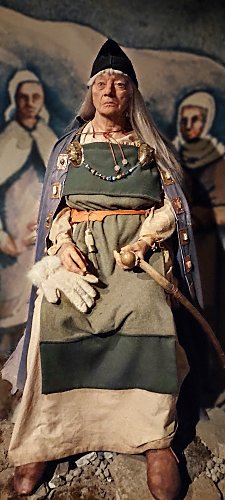
|

|
Žorbjörg litilvölva
born: ?
died: ?
Viking-age people believed that their world was filled with powerful forces and powerful beings. One of these forces was magic (seišr). Viking-age people seemed to have mixed views about the use of magic. It was thought to be effeminate, and using it was thought to be disgraceful, even though the art was taught to mankind by Óšinn, the highest of the gods. Both men and women practiced magic. When magic was used for evil, these people were despised and killed for spreading their evil. Ordinary men who took advantage of the evil magic worked by others were thought to be base and cowardly, such as Žorbjörn öngull, who used magic to overcome Grettir.
But when magic was used for good, these people were admired. Žorbjörg was such a woman. She was asked to visit the farm of Žorkell during a time of famine to predict the fate of the community in Greenland.

|
In the district there lived a woman named Thorbjorg, a seeress who was called "little prophetess", who spent the winter visiting one farm after another where she had been invited. When she arrived, she was wearing a black mantle with a strap, which was adorned with precious stones right down to the hem. About her neck she wore a string of glass beads and on her head a hood of black lambskin lined with white catskin. She bore a staff with a knob at the top, adorned with brass set with stones on top. About her, she had a linked charm belt with a large purse. In it she kept the charms which she needed for her predictions. She wore calfskin boots lined with fur with long, sturdy laces and large pewter knobs on the ends. On her hands she wore gloves of catskin, white and lined with fur. Eirķks saga rauša, ch. 4 |
Žorbjörg was served a special meal prepared from the hearts of the various animals available on the farm, and the next day, she prepared to work her magic and see the future.
She said she needed the assistance of women who knew the Varšlokur, the songs to call the spirits. Gušrķšur said she had been taught the songs as a child, but that she would have nothing to do with the ritual since she was now Christian. Žorbjörg said that she could help others present on the farm by singing the songs, and eventually Gušrķšur consented. Many spirits were called to the spot and charmed by the songs, and Žorbjörg was able to see the future and tell the guests that the famine would break in the spring, and that a long, productive life lay ahead for Gušrķšur.
|
|
©2013-2026 William R. Short |